
As we mark the beginning of Black History Month, we look at “Always in Season,” a disturbing new documentary that examines lynching in the United States both past and present. It interviews Bryan Stevenson, founder of the Equal Justice Initiative, which built the National Memorial for Peace and Justice in Montgomery to remember the more than 4,000 African Americans lynched in the United States. It also looks closely at the case of Lennon Lacy, a 17-year-old African-American high school student who, on August 29, 2014, was found hanging from two belts attached to a wooden swing set in a largely white trailer park in Bladenboro, North Carolina. At the time of his death, Lacy was dating an older white woman. Local authorities quickly determined his death to be a suicide, but Lacy’s family and local civil rights activists feared authorities may have been covering up a lynching. We speak with Lacy’s mother, Claudia Lacy, and Jacqueline Olive, the director of “Always in Season.”
Transcript
AMY GOODMAN: We’re broadcasting from the Sundance Film Festival in Park City, Utah. As we mark the beginning of Black History Month, we turn to a disturbing new documentary that examines lynching in the United States. It’s called Always in Season. Among those interviewed in the film, Sherrilyn Ifill, director of the NAACP Legal Defense and Educational Fund, and Bryan Stevenson, founder of the Equal Justice Initiative, which built the National Memorial for Peace and Justice in Montgomery, Alabama, to remember the more than 4,000 African Americans lynched in the United States. This is an excerpt of Always in Season.
BRYAN STEVENSON: I think what most people have a hard time appreciating is, if you were black and alive in many parts of this country, the 20th century, you were always at risk. You were always a target. You were always an object to be victimized, to be humiliated, to be taunted, to be sexually exploited, to be killed. And there was no respite. There was never a moment when you were allowed to feel like you can be safe for just a little while. You were always in season.
SHERRILYN IFILL: Most black men were lynched because they were accused of having sexually assaulted a white woman, for murder or some violent act committed usually against a white man. But sometimes it could just be having violated the rules of, you know, not having tipped one’s hat or having left the side of the street when a white person was walking past. It could be being regarded as uppity. And it really involves a process of dehumanization, that the black man had to be physically restrained, that he was oversexualized, that he was naturally and inherently violent or something that’s not human. And it’s this very insidious process of dehumanization, that begins always with words, that allows average individuals to stand and watch and to participate, and sometimes cheer, while another human being is brutally murdered.
AMY GOODMAN: An excerpt from the documentary Always in Season.
But the film isn’t just a historical account of lynching. It also looks closely at the case of Lennon Lacy, a 17-year-old African-American high school student found hanging from two belts attached to a wooden swing set in a largely white trailer park in Bladenboro, North Carolina. The date, August 29th, 2014. At the time of his death, Lennon Lacy was dating an older white woman. Local authorities quickly determined his death to be a suicide, but Lacy’s family and local civil rights activists feared authorities may have been covering up a lynching. This is Reverend William Barber. At the time, the North Carolina NAACP and others have spent years trying to bring attention to Lacy’s death. Reverend Barber talked about the case on Democracy Now!
REV. WILLIAM BARBER: This young man was found on almost the exact date that Emmett Till was killed. He was found hanging, had the wrong shoes. Our own independent pathologist said there was no way he could have done this to himself. We’ve called for an independent investigation.
AMY GOODMAN: Well, this week at Sundance, I spoke to Lennon Lacy’s mother, Claudia Lacy, and Jacqueline Olive, the director of Always in Season. I began by asking Jacqueline to talk about lynching in America and why she focused on the case of Lennon Lacy.
JACQUELINE OLIVE: Lynching, for more than a century, was the ultimate tool of racial terrorism. It was the way, on a continuum of tactics, to maintain white supremacy. It was the way to keep black people policing themselves. It was the ultimate terrorism.
And so, I had been filming in communities for five years across the country where lynchings happened, looking out what people are doing right now in their communities for justice and reconciliation around historic lynchings, because it’s a long-term impact on the entire community. I thought I was finished filming, when I came across the story of Lennon Lacy, 17, found hanging from a swing set in 2014. My son was 17 at the time. And I couldn’t imagine how a mother could deal with so much trauma. And I knew what the community must be going through, because of what I had learned from filming over the years.
AMY GOODMAN: And so, tell you the details as you understand them—when it happened in 2014, the time of day, how Lennon’s body was discovered.
JACQUELINE OLIVE: Lennon was found in a trailer park not far from his home. And it was in the morning, so about 7:15 or so in the morning, in the middle of a trailer park, surrounded by probably about 200 to 300 feet of trailers surrounding him. And so, people were moving from school. It was a school day. It was a Friday, August 29th, 2014. People were moving from school. People were working, doing shift work, going to the local factory, Smithfield, and leaving about—going about their day. Yet no one saw what happened.
There was a 911 call at about 7:15. There was a woman who made that call. Lennon was 240 pounds. And his body was deceased, and so that’s heavy weight. The woman who made the 911 call is about 5’2”, 5’3”, and 125 pounds. And yet, somehow she cut him down. She had scissors on her and was able to cut him down. There are all kinds of inconsistencies in what turned out to be evidence in the case, and, sadly, turned out to be evidence that was quickly brushed under the rug.
AMY GOODMAN: Claudia Lacy, talk about that day—and I hate to make you do this, but you have been living this every day since then—how you learned what happened to Lennon.
CLAUDIA LACY: I was on the phone with my sister. A knock came at the door. The police officer, Chris Hunt, which is the sheriff of Bladen County, he said that “I need you to come and go with me.” And he wouldn’t go into detail why. So I got in my vehicle, and I followed him over to the trailer park. When I got out of my vehicle, state bureau investigator introduced himself to me. He said, “I need you to see if this is your son that we found.” I went inside the EMT, and I saw my son’s dead body in there.
AMY GOODMAN: In the ambulance.
CLAUDIA LACY: In the ambulance, yes, ma’am. In the ambulance. And I looked at him, and I examined his body like a mother would—in disbelief. But it was him. And like I told the state bureau investigator, whoever did this, it took more than one person to take him down, because my son was very physical, very healthy. And like I said, he would not have been taken down or do this to himself, because he was planning his football game, which was Friday, their first home game of the year for the school, the first school year, on that day. We had talked about it. He had worked very hard to get his position on the football team.
AMY GOODMAN: He was hoping to get a college football scholarship.
CLAUDIA LACY: Oh, yeah. Oh, yeah. Exactly. That was our plan. Absolutely, absolutely.
AMY GOODMAN: What marks did you see on his body?
CLAUDIA LACY: I saw a large abrasion over one of his eyes. And the thing that really puzzled me was that I saw no dirt, no grass, no blood. I saw the tear ducts had, you know, went down the side of his face. But I didn’t see any blood or anything like that. It was so dark in the EMT, I didn’t see the marks around his neck. But I felt them, because, like I said, I touched his body. And I’m like, “This is unusual.” And it really was shocking to me. I didn’t tell anyone at the time, but I smelled chlorine when I was close. And I’ve got very close.
AMY GOODMAN: Like a pool.
CLAUDIA LACY: Yes, yes. I really did. And I didn’t say anything to anyone about it until later on, because, like I said, when I walked onto the scene, they were wrapping up the crime scene tape. The police of Bladen County were.
AMY GOODMAN: They were—wait a second. They were wrapping it up, meaning—
CLAUDIA LACY: Yes, ma’am. Yes, ma’am. Yes, ma’am.
AMY GOODMAN: —taking it away from the swing set?
CLAUDIA LACY: Yes, ma’am. Yes, ma’am.
AMY GOODMAN: This was within an hour.
CLAUDIA LACY: Yes, ma’am.
JACQUELINE OLIVE: Before Claudia—
CLAUDIA LACY: But I didn’t know anything about it until after 12:00. I was not notified, because they didn’t know who he was, until after 12:00.
JACQUELINE OLIVE: Before Claudia could identify his body—
CLAUDIA LACY: Yeah, absolutely.
JACQUELINE OLIVE: —they were taking down the crime scene tape.
CLAUDIA LACY: Yeah.
AMY GOODMAN: The coroner, that you feature in the film, Jackie, says he knows, beyond a shadow of a doubt, that Lennon Lacy was murdered. How does he know?
JACQUELINE OLIVE: So, that’s the mortician, local mortician, who prepared Lennon’s body.
CLAUDIA LACY: Yes.
JACQUELINE OLIVE: F.W. Newton. And he prepared Lennon’s body. He actually knew Lennon. He had met Lennon for the first time a few days before at his uncle’s funeral. And F.W. Newton, in addition to talking about the bruises on his arm, on his forearm, that indicated that he might have been in a fight, as opposed to on the back of his arm or the top of his arm, he—there were many things that made him think that Lennon had been murdered. And he was convinced that people would see that, and was really shocked that it had gone all the way to the medical examiner’s office with the assumption that it was—still holding assumption that it was suicide.
And I want to point out, too, that that interview with F.W. Newton was the only official interview that we got. We tried to interview the medical examiner, tried to interview the coroner, the DA, the chief of police, and no one would talk.
AMY GOODMAN: And so, the only person who talked was?
JACQUELINE OLIVE: The mortician, F.W. Newton.
AMY GOODMAN: Why wouldn’t the others speak?
JACQUELINE OLIVE: I don’t know the motivation, but they declined an interview.
AMY GOODMAN: When did they start saying suicide, Claudia?
CLAUDIA LACY: The day they completed their investigation, which was approximately four days after. Matter of fact, if you listen to the 911 call, she called it, that time, when she made the call, “He hung himself.”
AMY GOODMAN: Who said that?
CLAUDIA LACY: The 911—the person that called, in the call.
AMY GOODMAN: Nine-one-one.
CLAUDIA LACY: The 911 person that—
AMY GOODMAN: The one who the—
CLAUDIA LACY: —found his body. She was the one that said he hung himself. Suicide was then determined, if you ask me, because after that, that’s all—that’s the way it went. They didn’t come and check for any evidence of—you know what I’m saying? Suicidal note, no—they didn’t question any of the family to see if any of his behavior changed or any of that. There was none of that done. None of it.
AMY GOODMAN: Jackie Olive, you intersperse the story of Lennon Lacy with re-enactment of lynchings and the history of lynching.
JACQUELINE OLIVE: That’s right.
AMY GOODMAN: If you can talk about this, what had been going on in the county—it’s very unusual—to keep the history alive of what had happened to the black community?
JACQUELINE OLIVE: And so, one of those communities where I had filmed is in Monroe, Georgia, where a group, a diverse group of people, they get together annually to re-enact a 1946 quadruple lynching of two couples, the Malcolms on the Dorseys. And they do that to make sure that the victims are never forgotten. And the lynching was in 1946. My mom was alive in 1946, so that’s a generation ago. And so they believe that some of the perpetrators may still be living there.
AMY GOODMAN: So, talk about this re-enactment of lynching.
JACQUELINE OLIVE: Sure. So, the Dorseys and the Malcolms were murdered on July 25th, 1946. And so, around that time, that weekend, in Monroe, which is about 40 minutes outside of Atlanta, a group of people get together, and they dramatize scenes from the narrative of that lynching. And it’s their way of writing their own history and writing their own narrative, a history that’s been undocumented, in some ways, and incorrectly documented, in others.
And so, the re-enactment begin on a hot July day. It’s really hot, if you know anything about the Atlanta area and the South, and still people come out, and they caravan from scene to scene. They begin at a church that is the site of the gravestones where the victims were buried. And then they move to the jail, where one of the victims, George Dorsey, was held. And then they re-enact that scene. Because what happened is, George Dorsey had come home from the war and had got into a fight. He was a sharecropper and got into an altercation with the landowner that he was working for. The landowner wasn’t killed, but George Dorsey was arrested. And then someone came to bail them out—another landowner—on the pretense that there was work for them. And so George called his wife, and his wife called her cousin, and Dorothy got her husband, Roger Malcolm. And they all came together, thinking that they were going to work. And the landowner drove them into the ambush on the Moore’s Ford Bridge. And so the final scene of the re-enactment happens in that site where the lynching actually happened.
AMY GOODMAN: So, you’re talking about public spectacles and lynchings, not in this case, but people came from miles around, sometimes a thousand people, to watch an African American be lynched.
JACQUELINE OLIVE: Absolutely. And sometimes the crowds were more than a thousand people. In Waco, Texas, in 1916, 15,000 white men, women and children came out to watch the lynching of Jesse Washington. And that has happened many times across the country, for over a century, from about 1872 to 1964. Experts believe that there were probably—they’ve recorded about 5,000, nearly 5,000, lynchings. And most of those victims were African Americans. They actually believe that the numbers are probably closer to 15,000. Those are just the numbers that they could document.
And so, the thing that really drove me about understanding this history is the impact, because if you can imagine that, in communities where half the people in your community came out to watch a lynching, by the thousands, and what that feels like to hear thousands of people in your community cheering the violence on, hearing the screaming, the laughing, the roaring, even if you weren’t in the midst of it, even if you didn’t agree with it, you still were impacted by it. And so, the question for me is: What’s been passed along from generation to generation in families, both black families and white families?
AMY GOODMAN: So, Claudia Lacy, as you watched this film, you know the story of your beloved son Lennon. But to see it put into this context, what was your reaction?
CLAUDIA LACY: It’s hard to explain. It’s heart-wrenching. And it just—it allows me to grieve, because it tells his story the way I wanted it to be told. And it shows people what I had to endure, not because of what happened, but where I was and the circumstances of how people tend to overlook right and wrong and choose who’s right and who’s wrong, who should and should not make choices to take matters into their own hands and do things that are inhumane. Being in a community that close and that small, and for you to say, “I don’t know. We didn’t see anything,” and to see her put it into words, into action, and to connect it with history, it’s terrifying.
AMY GOODMAN: So, where does your search for the truth go now? I mean, there are these deeply moving parts of the documentary, that—where Reverend Barber comes to demand accounting and to amplify your voice around the country.
CLAUDIA LACY: That’s what I wanted to do: start the conversation, so we can stop the hate and killing. Start the conversation, so no one can think they’re above the law. Start the conversation, so that when you have a job to do, do it regardless of color, creed, your circumstances. Whatever happen happen, but it needs to be done in a professional manner at all times, regardless of your social status. People need to be respected as human beings, sisters and brothers, mothers and fathers. If it was your child, wouldn’t you want to know that everything possibly legal, human and right was done to find out what happened?
AMY GOODMAN: Do you have any inkling at this point? It’s been more than four years. Did anyone come forward in this case?
CLAUDIA LACY: Lots of people did, but they were intimidated, just like she said. It’s a repeat of history—ran away, threatened, scared, locked up. Some of them was killed. My son and I heard a actual killing, but it was like an accident. You didn’t hear anything about it. There was tape, the whole nine. By the time we got to the scene where the car hit this person, it was all cleared up. You couldn’t see anything but the bloodstain on the sidewalk, in Bladenboro.
JACQUELINE OLIVE: And was that the man who lived across from the—
CLAUDIA LACY: Yes, yes.
JACQUELINE OLIVE: —in the trailer park where Lennon was found? The trailer—
CLAUDIA LACY: Absolutely.
JACQUELINE OLIVE: The trailer that was directly across from the swing set.
CLAUDIA LACY: Absolutely.
JACQUELINE OLIVE: Shortly after Lennon’s death, within 24 hours, was killed in a hit-and-run.
One of the many parallels to what’s gone on historically, that Claudia and Pierre and many people in Bladenboro have had to deal with, is that the trauma, the real tragedy of a possible lynching, is compounded by the denial and the cover-up. Not only do you have to deal with the death, but then you have to deal with people telling you that you don’t know what you’re talking about, that it’s not possible that your son might have been murdered. And so it’s a compounding tragedy that nobody should have to deal with.
AMY GOODMAN: Claudia Lacy, your final message to the world as you continue to search for what happened to your son?
CLAUDIA LACY: Be kinder to each other. Watch the movie as though it was your family. Understand what we’re trying to say and show you. It’s time to stop, and start healing.
AMY GOODMAN: That’s Claudia Lacy, the mother of Lennon Lacy, and Jacqueline Olive, the director of Always in Season. Claudia’s son Lennon Lacy was found hanging from a wooden swing set in a largely white trailer park in Bladenboro, North Carolina, in 2014. Bladen County, North Carolina, recently made national headlines after a Republican operative was accused of tampering with absentee ballots in the still-unsettled midterm congressional race between Republican Mark Harris and Democrat Dan McCready.
And that does it for our broadcast. To see our full week of coverage from the Sundance Film Festival here in Park City, Utah, go to democracynow.org.
I’ll be speaking at 1 p.m. today at the Park City Museum at 528 Main Street. It’s an event sponsored by Dolly’s Bookstore. It’s free and open to the public. And I’m really looking forward to addressing the students this morning at the Academy for Math, Engineering and Science—that’s AMES—in Murray, Utah.
Democracy Now! is accepting applications for a full-time, 1-year paid news fellowship. Details online at democracynow.org.
Special thanks to our crew here at Park City Television: Danielle Turner, Robby Johnson, Diego Romo, Brendan O’Leary, Kristin Parker, Jaclyn Daly, Yurivia Barrios, Ethan and Derek.

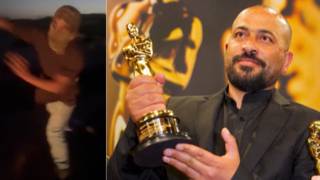
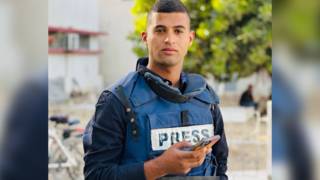
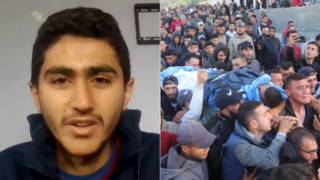
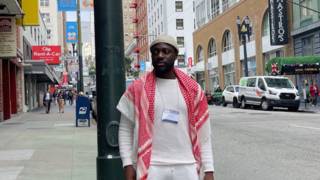



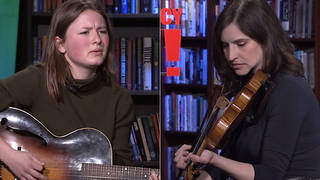

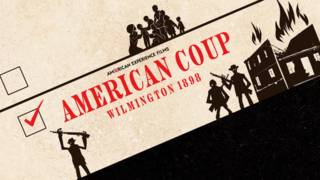
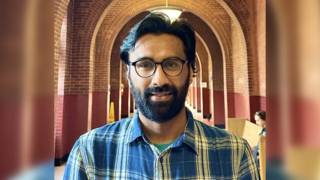
Media Options